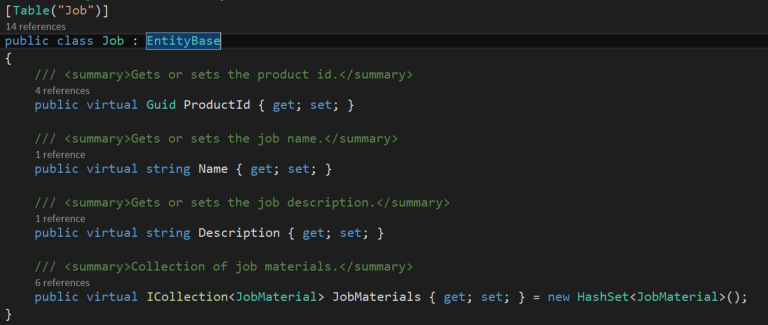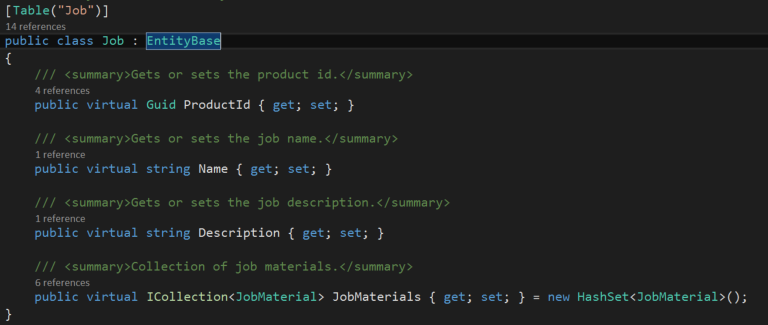Work with the data model and Entity Framework ORM
Describes goals, practices, usage, extensibility, and performance for the Configured Commerce data layer.
Optimizely uses Entity Framework for Configured Commerce. The following topics help you acclimate to the new data layer:
- Goals and best practices
- Basic usage
- Extensibility
- Performance
Goals and best practices
The goals of the Configured Commerce data layer are:
- Use the Entity Framework.
- Encourage a "thin" data layer, or a data layer whose entities have little to no business logic.
Entity Framework
Entity Framework (EF) is open source and part of the .NET framework. EF is the default object relational mapper (ORM) for Configured Commerce. This type of tool simplifies mapping between objects in software to the tables and columns of a relational database.
Skinny data model
We want to host all business logic in the service layer, leaving the entities as simple as possible. This eliminates complexity in the data layer and allows for better control and extensibility throughout the platform. We encourage you to follow this paradigm as you extend the platform.
Insite.Data
The Insite.Data namespace is the root namespace for entity-related components in the Configured Commerce framework. The models are Insite.Data.Entities and many other data-related components are included this namespace. Insite.Data is the main dependency for all data layer-related logic.
Basic usage
Unit of work and repositories
The recommended way to access data is to obtain a UnitOfWork object, get the appropriate Repository<T> object, and use that repository to access the entities.
Retrieving entities
To get an entity by Id, get the object by its primary key by calling the Get method on the corresponding repository.

Get a list of entities
To retrieve a list of entities, call the GetTable method, which returns an IQueryable<T> that can be filtered (where), sorted (orderby) or mapped (select).

Also, if you would rather write your own optimized SQL for retrieving the entities, you can do so and call GetList.
NoteThis will return the values immediately. This method should be used with care and only when necessary.
Retrieve related data
Lazy loading
By default, lazy loading is enabled and can be used to retrieve entities and collections of entities related to your entity in the database. A separate SQL call will be made once the collection is accessed in the code to retrieve these entities. In the example below, there are two SQL calls made, one for the Get and one when Job.CustomProperties is accessed.
Eager loading
Although lazy loading is great for a number of use cases, it is sometimes advantageous to load collections ahead of time if you know that you are planning to access them. This optimizes the process by making only one SQL call.
In our last example, we always access the CustomProperties collection, so instead of lazy loading that collection, we can eagerly load it via the Include method provided by Insite.Data.Extensions.
NoteYou must return an IQueryable to use this method.
Update entities
Create an entity
Creating an entity consists of constructing a new instance of the desired entity type, and calling the Insert method on the corresponding repository.
NoteTo actually save the entity to the database, you will also need to call either the Save or SaveAsync method on the UnitOfWork. That will be covered in the next SubTopic.
Update an entity
Updating an attached entity requires an update to the instance, followed by a call to the Save method on the UnitOfWork instance.
You can also perform a Save asynchronously by calling SaveAsync on the UnitOfWork instance.
NoteYou do not have to call Save or SaveAsync immediately after updating the entity.
Delete an entity
Deleting a job requires you invoke the Delete method on the Repository, followed by Save or SaveAsync on the UnitOfWork.
NoteYou do not have to call Save or SaveAsync immediately after updating the entity.
Extend the data model
Alter the data model
The officially supported best practice and method for changing the data model is to add entities to the model. Removing Optimizely tables is not supported. See Creating Custom Tables with an Entity and WebApi for details about table extension.
Create an entity class
To add to the data model, you should first create a POCO (Plain Old CLR Object) that extends from Insite.Data.Entities.EntityBase. For this example we have created the Job class.
In the previous image, notice that a Table attribute/annotation was added to this class. This is superfluous as convention assumes the name of the class. A list of common annotations for EF can be found in Code First Data Annotations.
Add properties
Once your class is created, you can begin to add properties. Properties can be of varying types, including other entities, but must have "virtual" as part of their signatures. Keeping in mind the principle of a "thin" data layer, it is best practice to leave out computed properties or methods. Our example adds the following:

Map the entity
Once you have created your entity class, you must create a mapping class. This class defines any custom relationships that are outside of standard entity framework conventions. Since our example follows convention, we don't require any logic. Still, we need to create the class, and it must extend from Insite.Data.Providers.EntityFramework.EntityMappings.EntityBaseTypeConfiguration<T> for your entity to be bootstrapped to the context correctly.
Primarily, you will only need to add custom mapping logic to your mapping class if there is a many-to-many relationship between your entity and another. If this is the case, then you can follow standard entity framework guidance on creating this mapping.
Alter the database schema
Migrations
Migrations are not currently supported. Any changes made to the database schema need to be done via SQL files embedded in your custom dll's.
Create a script
Creating a script consists of adding a new SQL file to your Visual Studio Project. The file should have the format of <year>.<month>.<day>.<increment>.<description>.sql. These can be added anywhere in the project's folder structure.
Include a script
Including a script into the build consists of setting the Build Action property of the file to Embedded Resource and the Copy to Output Directory property to Do not copy.

Run a SQL script
SQL scripts that are embedded resources are run automatically during the bootstrap operation. If the SQL script executes successfully, it is added to the DatabaseScript table in the database. This is done for auditing purposes, and to ensure that a script is not run twice. You can query this table to determine if your script has been run.

Performance considerations
Retrieve records
WithNoTracking
Another optimization that can be made is to work with a set of data that doesn't have change tracking enabled. This improves read performance, and can also improve the performance for batch operations.
Entity Framework accomplishes this via the AsNoTracking extension method, found in DbExtensions.AsNoTracking Method.
To limit dependencies on Entity Framework, Optimizely Configured Commerce exposes the same functionality on all of their repository instances. To get a collection without tracking, invoke the GetTableAsNoTracking method on the Repository. For example:
public ICollection<CustomProperty> GetJobCustomProperties(Guid jobId)
{
var job = this.unitOfWork.GetRepository<Job>().GetTableAsNoTracking()
.Where(j => j.Id == jobId)
.Include(j => j.CustomProperties)
.FirstOrDefault();
return job.CustomProperties;
}Typical usage would be scenarios where no updates to the entity are expected, or optimized sections where ObjectState and attachment to the context will be actively managed.
Updated 2 months ago